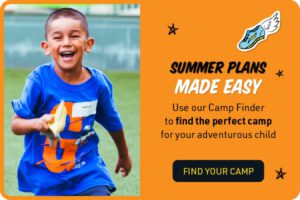With school out and long summer days on the horizon, kids have a sizable chunk of free time on their hands. And with a bit of planning, parents can transform what otherwise might become aimless hours into fun opportunities for learning, exploration and play.
Are you ready to make some lasting memories? STEAM arts and crafts are the perfect avenue.
Unleash your kids’ creativity with these four hands-on, summer art projects that inspire imagination and keep them engaged.
What Are STEAM-Centric Summer Art Projects for Kids?
STEAM stands for Science, Technology, Engineering, Arts and Mathematics. This modern approach to creative projects integrates arts and design into traditional STEM activities.
It goes beyond arts and crafts by weaving in elements from these various educational disciplines. In doing so, the artistic process evolves beyond simple creation to also focus on developing deeper levels of understanding, problem-solving, and innovation skills.
For instance, a child might craft a sculpture (Art) that uses a simple pulley system (Engineering) to move parts of it or paint with colors that they’ve created through a chemistry experiment (Science).
These types of projects encourage kids to think critically, innovate and connect different disciplines via real-world applications. The end result? A more holistic and memorable learning experience. It’s where the melding of hands-on creativity meets logic.
4 Fun Summer Art Projects for Kids
#1 Baking Soda Volcanos
The baking soda volcano is an iconic science experiment and art project, bringing to life the drama of a volcanic eruption in a safe and captivating manner. This effervescent experience allows children to witness firsthand the fizz and flow of a chemical reaction, while still being a fun art activity that allows kids to unleash their creative side.
Materials Needed:
- Baking soda
- Vinegar
- A small container or soda bottle (to act as the core of the volcano)
- Craft paper or clay (for shaping the volcano exterior)
- Food coloring (optional, for colored lava)
- Dish soap (optional, for a more bubbly eruption)
- A tray or basin (to contain the mess)
Steps involved:
- Place the small container or bottle on the tray or basin. This will act as the volcano’s core.
- Shape the craft paper or clay around the container, forming the exterior of the volcano. Ensure the container’s opening remains unblocked.
- (Optional step) Let your child paint the volcano for a more realistic and personalized touch. Using acrylic or washable paints, they can add features like lava channels, vegetation or even little dinosaur figurines around the base.
- Fill the container about halfway with baking soda. Add a few drops of food coloring and a squirt of dish soap for added bubbles.
- Slowly pour vinegar into the container’s opening and stand back to watch your volcano erupt!
- (Optional step) With colored pencils, trace the edge of where the lava flowed, then dab up the fluids. Cover the area inside the traced line with a thin layer of one color of play dough to mark the lava flow.
- (Optional step) Repeat the process, changing playdough colors between eruptions to see the distinct layers of lava.
Learning Outcomes:
This science and art project allows children to explore the chemical reaction between baking soda (a base) and vinegar (an acid). The reaction produces carbon dioxide gas, creating the bubbling and fizzing eruption effect. It’s a tactile and visual experiment that provides chemistry insights while simulating the wonder of natural geological phenomena.
If your child is more imaginative or artistically inclined, you may want to spend an extra half-hour designing the trees, lego figurines who are running from the lava and any safety boats that will help friends and animals off the volcano. Remember, this science experiment is meant to be fun!
#2 Sugar Rainbow Density Tower
Dive into the colorful world of density with a sugar rainbow tower. Not only does this project make for an engaging visual spectacle, but it also offers kids a hands-on lesson on the varying densities of sugar solutions.
Materials Needed:
- Sugar
- Food coloring
- 6 small cups
- Safety goggles
- Beaker
- Pipettes
- Stove and small pot
- Tablespoon
Steps involved:
- Preparation – Have your child put on the safety goggles. Parents, boil 2.5 cups of water on the stove.
- Sugar Distribution – Distribute ⅓ cup of the boiling water into each of the 6 cups. Starting from the first cup (with no sugar) to the last cup, incrementally add a tablespoon of sugar (0 to 5 tablespoons).
- Coloring – Add different food colorings to each cup, corresponding to the sugar quantity (e.g., red for no sugar; orange for two tablespoons; etc.) Stir until the sugar is completely dissolved.
- Layering – Using a pipette, pour the colored sugar solution into a beaker, starting from the most sugar-dense to the least. Ensure the liquid runs down the beaker’s side to prevent mixing and maintain separate layers.
- Observation – Once all layers are added, place the beaker on a windowsill and have your child observe the distinct layers. For an added experiment, insert a drop of water into the bottom layer using a pipette and observe its movement through the layers.
Learning Outcomes:
The sugar rainbow art activity demonstrates the concept of density in liquids. The amount of sugar in each solution alters its density, causing the colored layers to stay distinct unless mixed. Children can understand that the more sugar a solution has, the denser it becomes. If you’re looking for fun summer art activities, this one is sure to be a winner.
#3 Ice Painting
This summer craft not only offers the joy of painting with the sensory fun of ice, but it also seamlessly integrates a lesson about the various states of water. As the solid ice melts into a liquid, kids will witness firsthand the transition between these states, all while creating a mesmerizing blend of colors and patterns.
Materials Needed:
- Ice tray
- Water
- Food coloring
- Large tray
- 11 in. x 14 in. white Poster Board
- Plastic spoon
- Craft sticks (optional: for freezing one into each cube as a handle)
Steps Involved:
- Preparation of ice block paint – Fill the ice cube tray with water. Be careful not to overfill to prevent color mixing. Add 1-2 drops of food coloring to each section then insert a craft stick into each section to act as the paint brush handle. Freeze until solid.
- Setting up the canvas – Lay the poster board on a large tray. Release the frozen-colored ice cubes onto the board.
- Painting time – Have your child spread and glide the ice cubes over the poster board. As they melt, they’ll deposit their colors onto the canvas. Continue until the entire board is covered, leaving no white spaces.
- Cleanup – Pour off the melted water.
- Drying – Hang the icy artwork to dry.
Learning Outcomes:
Ice painting teaches kids about the process of melting and the properties of water. They’ll observe how solid ice turns back into liquid water and how different colors can blend together when they mix.
#4 Leaf Rubbing
Turn a nature walk into an educational adventure and art project by gathering different types of leaves along the way. Once you return home, your child can perform a leaf rubbing that results in a stunning artistic display of the intricate designs and patterns of nature, all while learning about the diverse world of plant life.
Materials Needed:
- A collection of unique leaves from your walk
- Various paper types (wax paper, tracing paper, parchment paper)
- Art mediums (crayons, oil pastels, colored pencils)
Steps Involved:
- Arrange the collected leaves on a flat surface.
- Select a leaf and position it beneath your preferred paper.
- Using your art medium of choice, gently rub over the leaf to reveal its pattern on the paper.
- Have your child label the different parts of the leaf.
Learning Outcomes:
Engaging in this leaf-rubbing activity allows children to dive deep into the captivating realm of nature and botany. As they bring out the hidden patterns from each leaf, they not only hone their artistic skills but also deepen their understanding of the role and importance of the various types of leaves in our ecosystems.
What Are the Benefits of Steam-Centric Arts and Crafts?
STEAM-centric arts and crafts offer an enriched learning experience, equipping kids with diverse skills and knowledge that will serve them well in the future, regardless of the path they eventually choose.
And the tangible benefits are clear:
- Holistic learning – By blending STEM with the arts, children can apply educational lessons in unique ways. Such summer art activities engage both the logical and creative sides of their brain while fostering a more integrated and versatile thought process. This combined approach not only deepens their understanding of complex concepts but also empowers them to think outside the box.
- Enhanced creativity – Advanced applications encourage innovative thinking and often require problem-solving. Kids learn to approach problems creatively, devising unique solutions, analyzing outcomes and adjusting their strategies accordingly.
- Practical application – Crafting projects offer a tangible way to understand some of the more abstract STEM concepts and see how they apply to real-world scenarios. For example, building a popsicle bridge can illustrate the principles of engineering and physics.
- Boosted engagement – Arts make STEM activities more relatable and fun than a typical school lesson. Children are more likely to be engaged when learning is interactive and visually appealing, especially if it’s a fun summer craft like the ones above.
- Encouraging collaboration – Many STEAM projects can be collaborative. Working together with friends, siblings or fellow campers fosters teamwork, communication and the appreciation of diverse perspectives.
- Skill development – Beyond academic knowledge, children develop motor skills (through crafting), observational skills (through science experiments) and creative skills (through artistic application).
- Building confidence – Completing a STEAM-centric craft gives children a sense of accomplishment. They gain confidence in their abilities to create, innovate and problem-solve.
Learning with Camp Galileo
Summer break is an opportunity for growth, learning and experimentation. Whether your child is at home or summer camp, STEAM arts and crafts projects are hands-on activities that they’ll remember for years to come.
But the magic doesn’t have to end there.
At Camp Galileo, we elevate these types of experiences, merging fun with engaging learning experiences. Our programs, tailored for summer, challenge campers to dig deep, think through solutions to challenges and develop the conviction to bring their ideas to life. These are skills which will serve them well into the future. Whether working on stimulating STEAM activities or enjoying outdoor games with friends, our summer camp offers a wide variety of fun activities to keep your camper entertained all summer long. Dive into a world where summer memories are crafted with purpose and passion.
For a traditional summer camp experience that champions fun and personal growth, enroll your kids in Camp Galileo. Explore our locations in California, Chicagoland, Seattle, Denver & Greater Colorado. If you’re near the California Bay Area, don’t miss the chance to explore our exciting San Jose Summer Camps. Enroll today at the location nearest you!
Wrap up your summer STEAM adventures with Camp Galileo—spreading magic in the SF Bay Area, Southern California (Manhattan Beach, LA, OC and SD), Chicago, Denver & Seattle. Join us at Camp Galileo and witness the transformation, where creativity meets learning, turning this summer into a canvas of cherished memories and learning to be courageous.
Explore our locations across California, Chicagoland, Seattle, and Colorado! Located in Southern California? Be sure to check out our Newport Beach summer camp or find the location nearest you with our Camp Finder.
Sources:
K12 Loop. 16 Super Cool (and Simple) 1st Grade Science Projects to Do at Home. https://k12loop.com/1st-grade-science-projects-to-do-at-home/
Jet Propulsion Laboratory. Make a Volcano. https://www.jpl.nasa.gov/edu/learn/project/make-a-volcano/
Steam Sational. 5-Minute Sugar Rainbow Density Tower Experiment. https://www.steamsational.com/sugar-rainbow-density-tower/
Crafty Thinking. Easy To Do Fall Arts and Crafts: Autumn Project Ideas for the Family. https://craftythinking.com/fall-arts-and-crafts/






